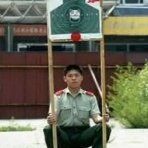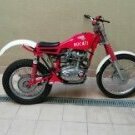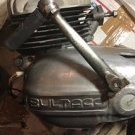
woody
Members-
Posts
4,058 -
Joined
-
Last visited
-
You don't say which Amal, but assuming it's a concentric, for a C15 it should be a 22mm which is the diameter of the standard intake. Different bikes won't necessarily run the same on the same jetting so it always a bit of trial and error. There is only one needle for the four stroke concentric of that size which is U1. Problems at high revs could be either too weak or too rich, If it's too rich it can cause the bike to choke on full throttle, too weak and it will gasp/die. Main jet size is normally around 100 or 110. There should be no pilot jet, needle jet 105 / 106 and it must be the 4 stroke type with spray holes. The jet holder is longer in the 4 stroke so the main jet sits lower in the bowl. Slide is usually a 3 If it is a premier type carb the same settings apply apart from the pilot jet which is a different design to the normal concentric, screws into the outside of the carb body opposite the pilot air screw and this is usually the three ring jet There could be other reasons for it not pulling up a climb, timing, cam type, different head with big valves etc
-
Fantics weren't produced with reeds until the 5 series, last air-cooled monos, which was about '89
-
Easiest identifier at a glance on the slimline models is that the 250 had a round barrel with closely spaced fins, 350 had a square barrel with wider spaced fins Ebay, facebook marketplace as well as a number of Bultaco facebook groups where you can see items for sale or ask for wanted items In the UK, In Motion have the biggest stock of parts
-
Last of the 'slimline' models from 1975 250cc. Model number is 150. Fkywheel and front wheel should be easy enough to find, exhaust more difficult
-
If you mean the production Sherpa N and Matador, I don't know either that well but although the frames share the same basic design I'd say the Matador is more bulky with more bracketry and reinforcement. The Sherpa N looks more bare like the Sherpa T I forgot one word when I mentioned about 669 NHO being based on a Matador frame and that was 'probably' I guess it could just as easily be based on a Sherpa N, which, thinking about it, seems more likely. It is known that the frame number of NHO begins with a 4
-
Yes, not just works teams either. The first 5 speed model 27 he had used the same plate as a later 4 speed bike. The original 669 NHO wasn't a Sherpa T as such as the T didn't exist at the time, the frame was a modified Matador, which is how the original NHO frame can be identified, from the mods and welds
-
I've never seen anything that gives information as to specific serial numbers for V1 and V2. It seems plausible that 1 - 479 are V1 but I wouldn't know for sure. The chart also says '1er' model for both but I'd assume that means 1st version of the Sherpa T. No idea what the reference to USA and Spanish versions are, the serials numbers don't carry a suffix A or N on the bikes and I think most were sold to the UK anyway. The features of the frame are likely to be the best identifiers of V1 or V2
-
It was owned by a private individual for years then sold a few years ago, where to I don't know
-
That bike is a replica
-
The bashplate mountings are different, on V1 there are two U shaped 2 bolt brackets welded to the frame, one just in front of the bottom engine mount, the other just below the front engine mount. The V2 only has one midway between the two engine mounts. The V1 engine has a smaller diameter shaft on th ignition side of the crank and doesn't have a lighting coil. The V2 has the bigger crank, same as later bikes and has a lighting coil Carb, airbox, shocks are all the same, wheels I'm not sure, I've seen it mentioned that the V1 rear hub had a cush drive (mine doesn't) and that it came with chrome rims, V2 had alloy rims V2 is said to have the frame number on the headstock whereas earlier bikes had it low on the frame by footrest or higher on seat rail but I think this can be inconsistent, my V1 has the number on the headstock and it's a low-ish number. V1 had a black bottom yoke, V2 was silver Obviously with the bike being near 60 years old anything could have been changed or modified in that time though
-
Put a picture of the bike on here or one of the facebook groups as it's a lot easier to identify the actual bike itself than from a frame number
-
Unfortunately prefix 51 covers the 348 and entire 349 model range so without knowing which number range was used for which model you can't tell what it is from the number
-
It doesn't sit too badly if they are the 610mm stanchions as I'd expect it to be more raked, but to ride they need to be raised in the yokes, or they steer like a barge - you can see how much room there is between the bottom yoke and mudguard for 6" of travel I wonder if it has shortened damper rods to compensate for the longer stanchions. Bit of a mystery nonetheless. The fork bottoms are correct for that bike
-
Mine is an early bike so has the square tabs, wasn't sure about a different clutch on later 4 speed engines From your picture it looks as though there is something sitting between the casing and the basket. I can see the raised boss to the left but next to that is something else (immediately to the left of the basket teeth in the picture) what is that as it sits directly in the line with the crank sprocket, which is where the basket teeth should be You can tell straight away if the crank weight is in the wrong position as the tensioner wheel should be directly underneath the teeth, otherwise it would miss the chain
-
Yes that's a TR77 Verde, the number run begining 70 for the 250 isn't listed on the Ossa reference sheets The MAR had shorter forks up until 1976 when the MK3 was introduced with laid down shocks and forks which were about 2" longer and these forks were also fitted to TR77 and Gripper - 2" is about 52mm which ties in with the length of the different stanchions sold by In Motion which differ by 50mm. (The part number for the stanchions is the same for MK3 MAR and TR77) I don't know which model, if any, uses 610mm stanchions, maybe one of the motocross or enduro models Normally on the MK3 MAR, TR77 and Grippers, the forks are raised by about 2" through the yokes as they are too long and give the bike a stance like a chopper. In the photo yours looks to sit level even though the forks aren't raised. With stanchions 1" longer again you'd expect the bike to sit really high at the front, but maybe it's an illusion die to camera angle





